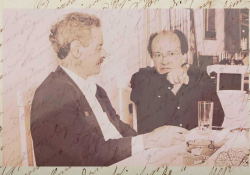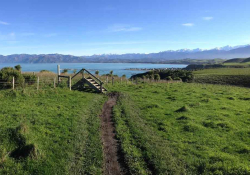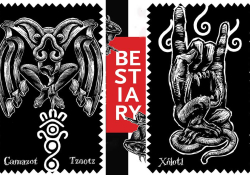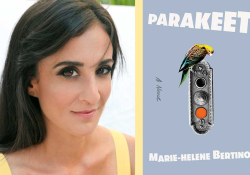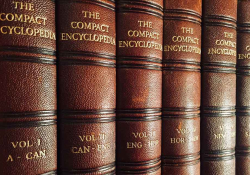Forging Friendships, Building Families: Pierre and Marie Cayol’s Odyssey with Native Americans
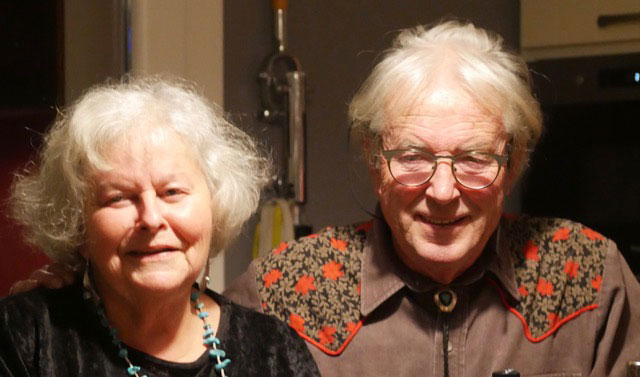
To know Pierre and Marie Cayol is to enter an immediate circle of friendship that reaches far and wide and represents a towering monument of achievements, ties, and ever-widening albeit discrete cultural influence. Sharing is the main imperative of this circle that is held together by the quality of Pierre and Marie’s work. Operating outside the Paris pressure cooker, they have patiently and indefatigably carved a creative universe that reflect their love for each other and for their work. They take the time to practice art as an extension of life, and life as an extension of art. To share their world is to discover their multiple cultural layers. The generosity of their presence in the region of Vaucluse-Gard and Camargue has created a nucleus of cultural exchanges that attracts connoisseurs from all over the world.
Pierre Cayol is a painter and engraver. After graduating from the École Nationale des Arts Décoratifs in Grenoble and the Académie Jullian in Paris, he studied under painter and pastellist Marcel Féguide (1890–1968), a great traveler in love with Provence and heir to the Romantics and Impressionists. Féguide became Pierre’s master teacher and mentor and taught him the vastness of landscapes and the quasitransparency of colors that seem to move across the canvas, the juxtaposition of planes, the knowledge of symbols, and the precision of the drawing.
As a painter, Pierre has quite a pedigree. He and Marie made their home in Tavel near Avignon in 1968, where they still live and work. He has shown his work numerous times in France and abroad (Belgium, US, Switzerland, Austria, Italy, Spain, Korea, Japan). Several of his works have been acquired by museums, and he has been Sociétaire du Salon d’Automne de Paris since 1984. For almost fifty years, he traveled almost every year to the American Southwest where, thanks to his Navajo, Apache, Hopi, and Pueblo friends, he learned Native American thought, mythology, symbols, and philosophy whose influence on his work have grown considerably. He has also produced stage decors for several plays that denote his talent for broad frescoes. As an engraver, Pierre is a master lithographer whose workshops have a solid reputation. This activity constitutes an important part of his activities, for he has illustrated over twenty livres d’artiste, which are collectors’ items.
Among the poets whose books he has illustrated are Francine Caron, Marie Cayol, Jean Joubert, the Belgian poet Béatrice Libert, Marc Alyn and his wife, Nohad Salameh, and Joseph Pacini. Pierre uses mostly linocuts but also etchings. Recently, he started illustrating bilingual selections by Native American poets, notably Gerald Vizenor, Scott Momaday, and Ofelia Zepeda.[i] His latest project involves illustrating seven Navajo songs of the night in a bilingual edition; the French text will be in the translation of Frédéric Jacques Temple, an almost centenarian French poet, translator, and writer born in Montpellier, and a lifelong friend of the Native American communities near Santa Fe and Tesuque Pueblo.[ii] While working in Arizona in the summer of 2018 on illustrating one of the poems, the Song of the Hogan, Pierre was invited to a puberty rite called Kinaalda, during which the Hogan Song was performed. Serendipity gave Pierre the perfect alliance between language, music, and visual representation.
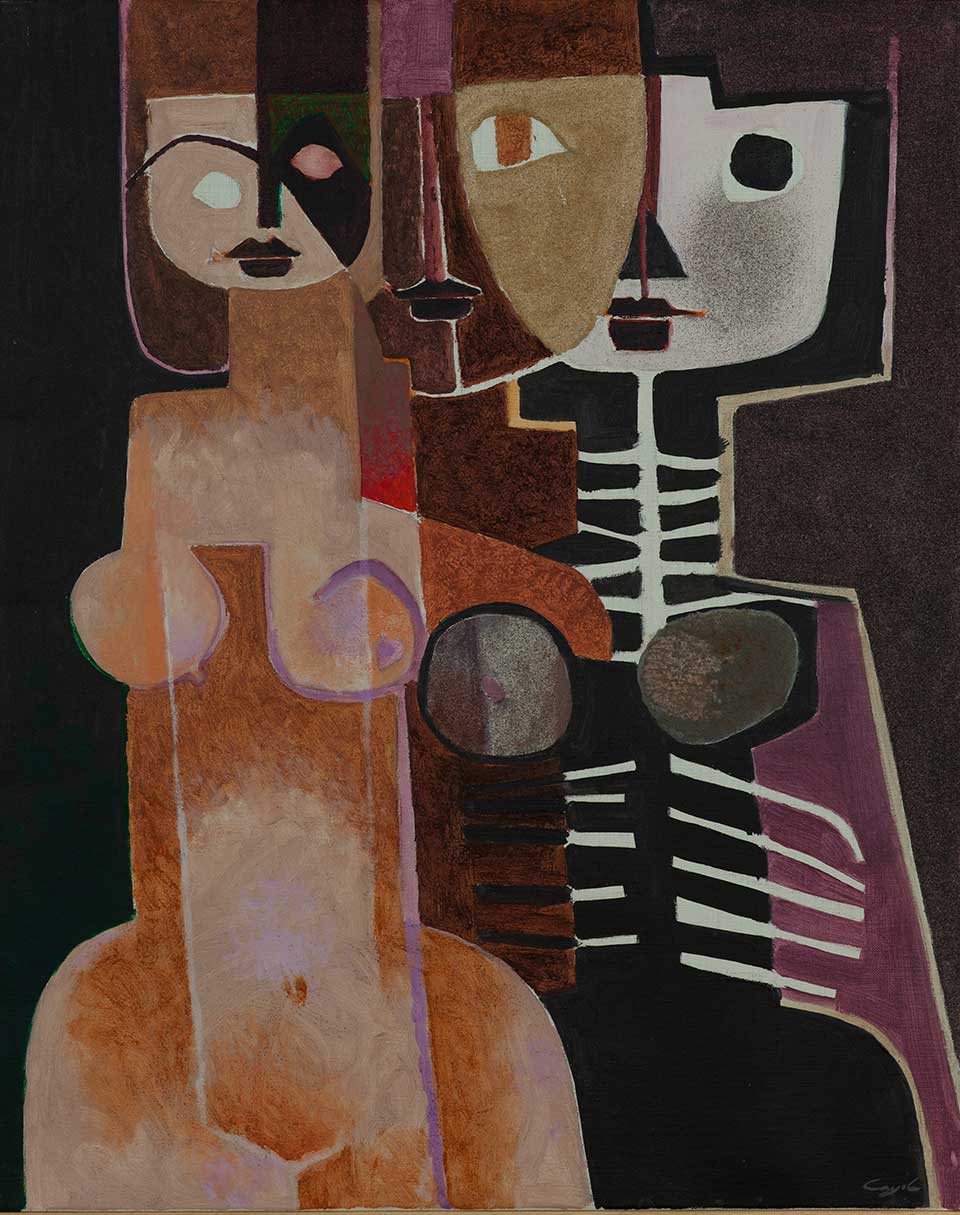
* * *
Marie graduated from the University of Aix-en-Provence and taught French literature until 2003. Since then, her creative writing, photography, and administrative work in support of her and Pierre’s cultural initiatives have taken front row, strengthening the unique bond that the two formed early in their life together. She has written several volumes of poetry, one volume of short stories, and four “ethnographic” travel books. She is also a regular contributor to the poetry review La Main millénaire, edited by Jean-Pierre Védrines in Lunel. She is the soul of Indianités and its main writer and editor. Pierre’s illustrations appear in her new volume of poems entitled Dinétah—In Navajo Land, which L’Atelier du Grand Tétras published in 2019.
Their home in Tavel has been in Marie’s family since 1800. In the garden grow a centenary olive tree and a mess of flowers, many inherited from her mother, as we see in her poem “To My Mother”:
Soft, the mauve and yellow columbines under her caressing fingers.
Heady, the fragrance of the lilies she offered to the Virgin Mary
in the niche by the garden gate.
Indefatigable, Mother devoted
every day to improve this little paradise
where cosmos, hollyhock, snapdragons freely
mingled with sweet peas and sweet williams.
Tirelessly deferring happiness
with an abundance of flowers,
those creations of nature
made to adorn the heart.
She loved them all, bestowed special care upon each.
Protected begonias and hydrangeas from the assaulting sun,
made sure that impatiens and phlox stayed fresh,
and fingered aphids off the China pinks.
Through the years, Pierre and Marie have nurtured lifelong “elective affinities” with Native peoples of the Southwest.
Since the 1970s, Pierre and Marie have spent several weeks with members of the Hopi, Navajo, Pueblo, and Apache communities in Arizona and New Mexico. As their friendships expanded, they also traveled to Montana, Wyoming, South Dakota, Minnesota, and Tennessee, even to Chile in 1997, where they met members of the Mapuche community. In December 1997 they founded a cultural association named “Indianités” and started publishing travelogues called “Indianités—De pierre et de sable.” Issued in about one hundred copies at the rate of one or two a year, the twenty-eight volumes of the journals have the weightiness of time accumulated, layers of knowledge that sustain and explain Pierre’s work as a painter and give a first audience to Marie’s literary and pictographic talent. Through the years, Pierre and Marie have nurtured lifelong “elective affinities” with Native peoples of the Southwest.
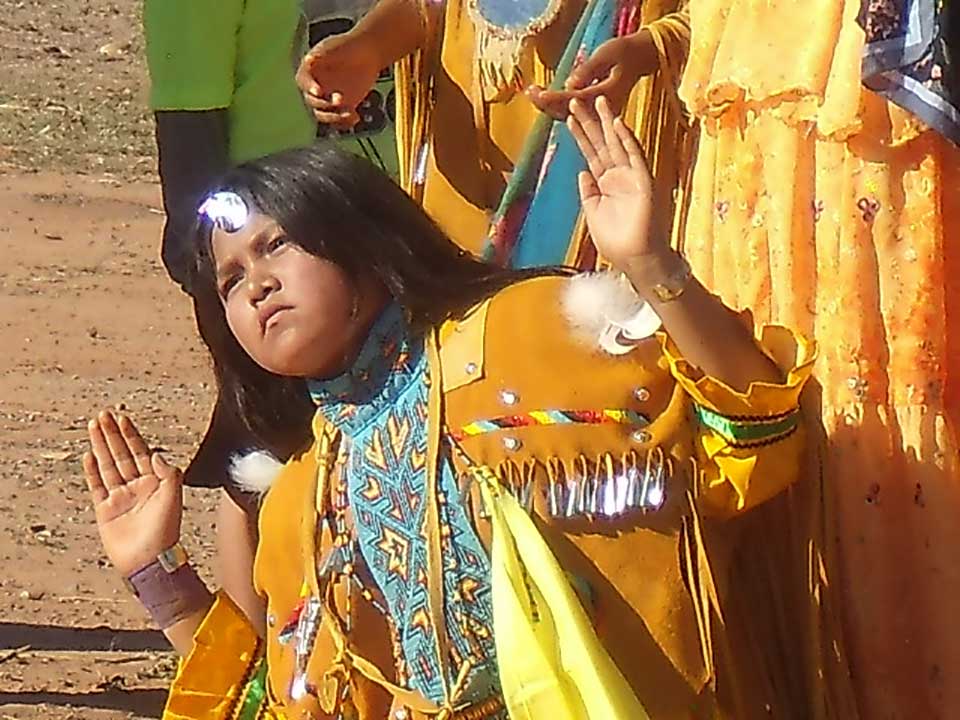
The travelogues are written by Pierre and Marie and occasionally by their sons, Blaise the basket weaver and Mathieu the flute player. All four have a unique kinship with the Hopi, Navajo, Pueblo, and Apache people, having gained their trust and friendship. Their blogs are a chronicle of Native American peoples, a rare narrative that reaches beyond the landscape, fauna, flora, villages, architecture, sacred ceremonies, and rock paintings to celebrate Native American artists and the lives of farmers and citizens, describing such ordinary tasks as cooking, planting, or fashion as works of art and sacred tasks. They interpret hogans, peyotl, medicine rituals, pueblos, and introduce Native vocabulary. They are also attuned to the history of Native American peoples. Their narratives, photographs, and paintings take their audience into a very ancient past. And yet they never omit to discuss the changes introduced by the Europeans in the lives of Native peoples.
Getting closer to the earth, which is how Blaise defines his basket-weaving activities, is a powerful theme that runs through the Cayol family.[iii] Through his mastery of a traditional folkloric art, Blaise stays close to the people. When they travel to Arizona and New Mexico, it is primarily for Pierre to explore his passion for these landscapes “of stone and sand.” Marie, meanwhile, befriends poets and writers, and Blaise sells his work at the International Folk Art Market in Santa Fe and participates in other basket weaving events. While they visit the best-known tourist destinations, they also befriend local people and have reached a level of knowledge of Native Americans that few westerners possess.
It all started with Pierre’s childhood fascination with the landscapes of the Southwest that remind him of the Alpilles massif of his native Salon-de-Provence. One of Pierre’s biggest fascinations is Navajo Mountain and its famous Rainbow Bridge. Pierre and Marie also favor the Canyon de Chelly and have visited the archaeological sites of Betatakin in Arizona, Mesa Verde in Colorado, and Chaco Canyon in New Mexico. They have met artists, writers in Tucson, Phoenix, Santa Fe, Flagstaff, and Boulder; these include Allan Houser, Apache sculptor; Melanie Yazzie, Navajo painter; Scott Momaday, Kiowa writer and painter; Anishinaabe writer Gerald Vizenor, whom they met in 2008; and Ofelia Zepeda, poet, writer, and academic, whom they met in 2014. Their contacts also include academics such as Marta Austin and Mary Washburn.
The historical friendships between Native American and southern French people is rich and storied, although not well known. Pierre himself during his youth often participated in the Camargue’s horse games. There, he learned about a colorful character, Folco, Marquis de Baroncelli (1869–1943). A disciple of Frédéric Mistral, the marquis specialized in raising purebred bulls and created the Manado Santenco (Holy Herd) in Saintes-Marie-de-le-Mer. In 1905, on the road to Arles, Folco met Oglala Lakota Indians from the Pine Ridge Reservation who were a part of Buffalo Bill’s Wild West show.
The first westerns ever filmed were made in the Camargue.
That same year, through his actor and regisseur friend Joe Hamman (1883–1974), he met William Frederick “Buffalo Bill” Cody (1846–1917). After 1909, the marquis loaned to Joe Hamman his guardians and bulls for his movies. And that is how the first westerns ever filmed were made in the Camargue. Joe Hamman played in ten films in 1909 alone, including The Vulture of the Sierra (three short movies), A Mexican Drama, and The Horseshoe. He also directed three short movies in which he played, The Desperado (1907), Drama in the Far West (1909), and The Adventures of Buffalo Bill (1909).
To say that Wild West themes were popular in Europe at the turn of the century is an understatement. After 1906, however, Cody returned to the United States for the last time. Folco “could not resist the thought of seeing his Indian friends one last time. As the boat unmoored, Jacob White Eyes, whom he had befriended, threw him a parcel that contained a beautiful Indian Chief headdress that has been preserved ever since at the Simbèu at Saintes-Maries-de-la-Mer.”[iv] Thus, through what Pierre Cayol calls “a quasi-mythical gesture,” were born the first ties between “two populations that feel very close to the land of their ancestors and Mother Earth,” ties that have remained strong for over a century.[v]
Pierre’s fascination with Wild West landscapes began with the Cémoi chocolate images that he collected when he was five.[vi] This fascination is related by Joseph Pacini in his study of Pierre’s work.[vii] Marie wrote about it in a lightly disguised story entitled “The Last of the Mohicans,”[viii] in which a little boy from southern France collects the pictures that were packed between the outside chocolate tablet paper wrapper and the inside chocolate silver foil. The pictures Pierre glued into an album told the story of the last of the Mohicans. Indeed, James Fenimore Cooper’s novel was popular among the youth of World War II. Pierre dropped the album on his way to an air raid shelter during an alert in the fall of 1944; a US bombing raid destroyed it. Many years later, Pierre told that Hopi kivas to him felt like the shelter provided by his farmer friends during the aerial bombardments of the last year of the war.
This episode is an example of a palimpsestic construct between the landscapes and cultures of Provence and the American Southwest. These include his awareness of the similarities between his native landscapes and the Arizona canyons, and of the ties between the Camargue and Native American horse culture. At the origin of this palimpsest lies yet another major childhood influence. When he was seven or eight, Pierre became fascinated with German Romantic painter Albert Bierstadt’s The Rocky Mountains, Lander’s Peak.[ix] To Pierre, this painting symbolized serenity and happiness. Thus began a connection between Romantic landscape painting, the Impressionists, and the National Parks and environmental movements that would shape Pierre’s entire work. Eventually, this love—Pierre’s search for plenitude and serenity—flowed naturally to Marie and to their two sons who shared their travel adventures while growing up.
Marie defines her discovery of Native American traditions and thinking patterns in a short story entitled “Les Roses de Taos.”[x] Describing her first impressions of the Taos pueblo, she acknowledges Native American thought as “conveyed through symbols” rather than by linear and abstract Cartesian concepts. She immediately related to the Native American association of reality and the imaginary, and she found a kindred demarche in its affirmation that art is inseparable from life, life inseparable from the landscapes in which it gets organized. With a sense of color and volume that shows her artistic temperament, she describes the Southwest as a blueprint where nature teaches man wisdom.
Another element that she discovered and appreciates is the respect for food, seen as an exchange between humans and nature, in which humans give a gift back each time they take something from the earth. In all her writings, Marie gives great attention to Southwest Native Americans’ food organization and production. Her concern is echoed by her son Blaise, who states that baskets were the earliest form of survival, the first food storage system: no food supplies, no human life. Basket-weaving for him has a spiritual dimension as well; the flat baskets remind one of the flat disk of the earth and the peoples’ migration from the Place of Origin, yet they also remind one of the sky. Creation, evolution, and humankind evoke the earth-sky relationship, the initial and the final, the informal and the formal, the hidden and the visible. The link between sky and earth must be acknowledged so that the sky will fecund nature and humankind in a new cycle. To weave is to pray, to send a spiritual message, to send forth one’s hopes and wishes and dreams, and to exorcise one’s fears and doubts.[xi]
* * *
The Cayol family’s love for and understanding of the culture of the people of the US Southwest has created not only an ever-widening circle of friendships but a tightly-woven circle of creation within the family. In a story entitled “The Pearled Barrette,” a young researcher, Brenda, attends a Roma festival in Camargue, a region known for its pink flamingos, wild horses, and flamenco songs. This is the disguised version of a true story, namely that of the encounter of Blaise and Mathieu with Colorado ethnomusicologist Brenda Romero, which led to a lifelong friendship with the Cayol family. Perhaps these affinities can best be summed up by Marie’s belief that “sometimes fated events in life resemble appointments . . .” This encounter, which was first narrated by Blaise in Indianités and then developed by Marie into a semifictional story, shows the long maturation process of shared and cross-referenced creation in the Cayol family.[xii]
In her short story “The Last of the Mohicans,” Marie presents a dialogue between a French painter (Pierre) and his Native American friend (Gerald Vizenor) that further develops elements of Native American thought and tradition that the Cayols adopted. Discussing the French painter’s scenes representing symbols, mythology, and history, the Native American friend says: “a union of lines, textures, and colors . . . how he defies gravity and balance through barely sketched forms, upset perspectives, held together by a discrete and rigorous construction.” Addressing him directly, he continues: “All your paintings are a wink to escape reality, to resist incomprehension and dissatisfaction, to raise one’s spirits to previously unattained heights. A way to overcome, to sublimate difficulty. You have this power to dream that Indians have. For, if we are still alive today, without rancor against adversity, if we escaped despair, it is thanks to the dream that feeds our visions. This explains that I like Chagall above all, because of his green-faced violinists perched on the roof, of his houses floating in the sky, upside down, and of his lovers who fly over the city.”[xiii]
Central to this analysis is the passage between different realities. Marie’s latest ethnographic book, Masayestewa: A Hopi Farmer, defines this passage as central to Hopi philosophy: “Suffice it to look at the sun’s voyage: it has two entrances, two ‘houses’ situated at each end of its course. Mornings we suppose that he comes out of his eastern house, and evenings it goes into its western house. During the night, it must travel underground from west to east to be ready to appear the next morning. Thus, day and night are inversed in the upper and lower worlds. This duality between the two worlds is one of the fundamental aspects of our vision of the world. The lower world, or underground world, represents the matrix in which each experience is born. At our death we return to the underground world. Day and night, summer and winter, life and death, are included in a system of alternance and continuity.” To escape real time, to escape reality, and to see everything as related are fundamental concepts, as in the Snake dance performed in Shungopavi in which a sky spirit (Youth Serpent) unites with an underground spirit (Girl Serpent) in order to renew nature’s fertility.[xiv] Mother Earth and Father Sky are inseparable, always complementary.
Pierre paints what Marie puts into words. Cultural passage for him is first of all a passage of landscapes and colors. While in Tavel, Pierre paints Arizona and while in Arizona he paints the Alpilles. He mentally comes and goes between both landscapes, superimposing both worlds on his canvas, reality and dreams, sky and earth, nature and symbols, in collage-fashion, paintings so full of “signifiers” that one must make time to unpack their full message. For Pierre, the problem is simple: Provence has simple colors but intricate forms; Arizona has simple forms but intricate colors. The Alpilles are given Arizona colors and Arizona the texture and shape of the Alpilles. Thus, Pierre’s native and adoptive landscapes become one through the affinities between their respective mineral worlds. Their writer friend Jean Joubert sees in this process the creation of “a happiness aura” and calls Pierre Cayol “a poet of painting.” Indeed, Pierre’s paintings reflect a deep serenity, a translation of the harmony between man and nature. In Native American parlance, Pierre has found the one landscape awaiting him, corresponding to his nature, a mirror of his uniqueness. A camaïeu of colors enhance the liberating lines that underscore the immobile motion of the stone. The paintings’ watchful balance and their quiet sensitivity invite the viewer to divine the multiple resonances between nature and man. Symbols accumulate: petroglyphs, peyotl bird, tortoise, blue cicadas, Kachina dolls, and colorful fabrics. Pierre Cayol creates paintings within his paintings; resonances are an intrinsic part of his work, uniting themes held across time by a great unity of purpose.
For Pierre, the problem is simple: Provence has simple colors but intricate forms; Arizona has simple forms but intricate colors.
Pierre’s work is sober and generous, vast and fecund, a pleasure for the eye and the soul. Like Marie’s writings, which echo one another, Pierre’s paintings echo themes treated in different media (pencil, mine, oil, watercolor, acrylic paint, and linocut), as if infinite variations wove a dialogue within uninterrupted creative meditations. Even his paintings devoted to non-American themes (nudes and natures mortes) celebrate the primal beauty of the world and allow the viewer to relate to them immediately through a balance between emotion and mind. Emotion caused by the colors; mind that must decipher the geometry of the paintings and their significations. The result is superimposed and overlapping forms and colors. Pierre likes to cite Van Gogh’s statement about the artist needing “a lot of drawing and few colors.” Indeed, he paints in contrasts (shadows/light, transparent/opaque) that provide yet another oscillation of the brain between emotion and rule that allows artist and viewer yet another passage—a journey toward the infinite, the existential, the primal.
Pierre’s paintings reconcile the sacred with reality. His biographer, Joseph Pacini, writes that Pierre is a traveler searching for the unattainable; in him pass nature, earth, air, water, and fire, mountains, deserts, and oceans, in searching to find the source of his desire to paint. Another writer, poet, and friend, Marc Alyn, writes of the transformation of solid matter into pure light in his paintings. Indeed, the blue hues in his paintings, especially in his Homage to Van Gogh, have exquisite softness and warmth. In his book Cayol: Peindre le désir, Pacini celebrates Pierre’s sensitivity to nature and people and writes that painting for him is a ceremony in which space, time, and matter meet to give shape to the incandescence of light. This is how Pierre’s paintings reconcile the physical and metaphysical worlds.
Like Pierre, Marie does not exclusively deal in Native American topics. Her trademark is her unflinching attentiveness as a listener and reader. Mémoires provisoires: Entretiens avec Marie Cayol, a series of interviews with French poet Marc Alyn, shows the depth of her understanding of him as a person and a poet. Her questions elicit information about the lesser-known parts of his life, his everyday actions and contacts with artist friends, away from the limelight; she brings about the best in him, and the result is a finessed portrait. A quintessential team player and selfless supporter, she acknowledged the contributions of Marc Alyn to the book by listing him as the author of the book, while her name appears in the subtitle. Alyn cited this volume as the basis for his recently published memoirs, Le temps est un faucon qui plonge.[xv] Marie practices writing as a shared occupation, weaving subtle threads between themes that remind the reader of the equally subtle yet strong friendship ties between authors.
As for her writings about Native American people, Marie has thus far devoted one book to each befriended nation. But, before discussing them, one must mention Pierre’s series of four paintings entitled Homage to . . . and dedicated to the Navajo, Hopi, Apache, and Pueblo nations. These four paintings echo Marie’s four ethnographic books dedicated to the same nations. They were indirectly inspired by a series of three large frescoes by Ambrogio Lorenzetti (1290–1348) placed in the council room of the Siena town hall. This extraordinary representation of the allegory and effect of good and bad government provides an important key to understanding Pierre’s treatment of landscapes. First is the painting’s concept of space (these frescoes represent the largest landscape ever painted in medieval art, in realistic fashion depicting everyday life); second is the harmony between nature, urban landscape, and human activity. Pierre’s entire philosophy of representation is based on the frescoes, which deeply impressed him. His four “Homage to” paintings are a construction—almost a collage—uniting in their architecture landscapes, objects, and symbols.
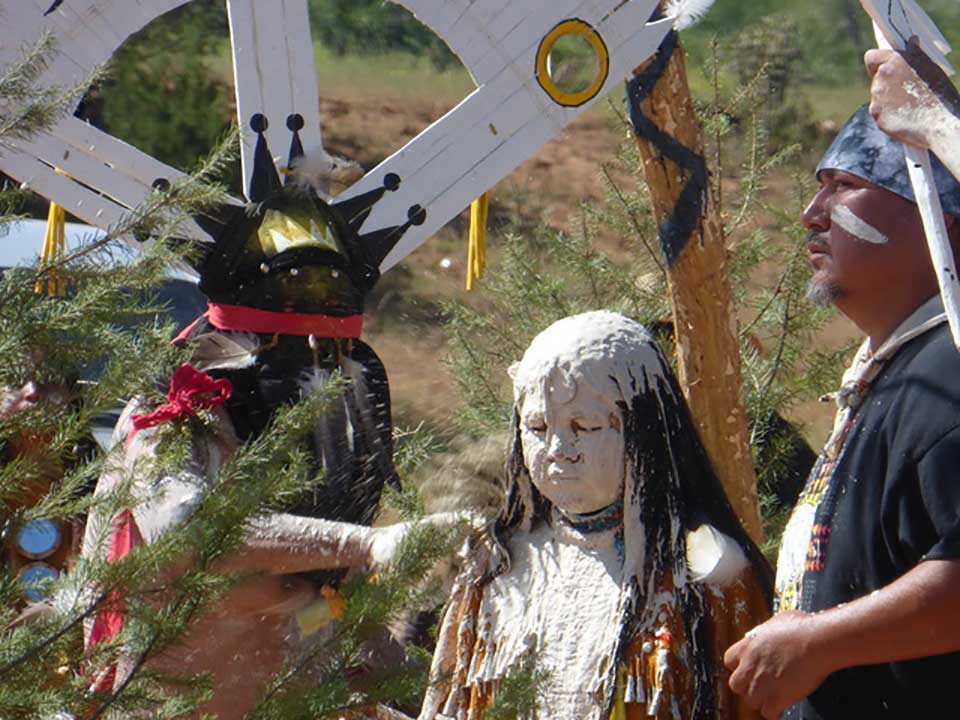
In 2006 Editions du Rocher / Nuage Rouge published Pierre and Marie Cayol’s Apaches: Le Peuple de la Femme Peinte en Blanc, with a preface by N. Scott Momaday who qualifies their collaboration as “a happy collaboration, an extraordinary complicity between husband and wife.” This book, which focuses on the Apache puberty rite, is richly illustrated by photographs taken by Marie, whose eye is as excellent as her prose. Commenting on Marie and Pierre’s collaboration, Momaday waxes poetic. Of Pierre he says, “I have seen him study a landscape, sketch it with quick and precise lines, then paint it on canvas with remarkable mastery. His paintings retrace the geology and the sacred nature of the earth. He perceives the landscape like Indian people, feels it deeply in its spiritual dimension, and admires it reverently.” Of Marie, Scott Momaday writes that she adds to Pierre’s affection for the Indian world “a supplement of penetrating insights and eloquence. She has a poet’s talent, a love for language, and a quality of expression that is all clarity and concision. Her images are immediately evocative, revelatory—small masterpieces of composition and suggestion.”[xvi] Pierre and Marie were introduced to the Apache world through Diana and Gibson Aday, whose children they saw grow up year after year, as well as through a retinue of artist or educator friends. This means many returns and an accumulated wealth of knowledge through the years that is faithfully translated: every statement of Marie and Pierre is true and faithful to the reality of the Apache people. The reader meets a host of people, from regular Apache families to clan leaders, directors of research centers such as the Tiller Research group, members of the tribal councils, women, children, medicine men, veterans, writers, and artists, including Native American artists who, like Perry Smith, live in Paris. Some of these characters appear in Indianités, in poems, or in Les Roses de Taos. They form a circle of friends, a mirror of life in uninterrupted fullness—from birth to death, from nature to humanity, from animals to crops, from tradition to modernity.
Of Marie, Scott Momaday writes that “her images are immediately evocative, revelatory—small masterpieces of composition and suggestion.”
The following book, Navajo Mountain: La tête de la Terre-Mère, Natsis’ààn,[xvii] shows the same pattern. Marie describes the life of Navajo friends Helen and Jerry Smallcanyon, whom they have known since 1981, when they first made their trip with Blaise, then eleven, and Mathieu, then eight. Over their return visits for several years, they became known as “the one who paints and her who accompanies him.” The book was prefaced by Helen and Jerry’s daughter-in-law, Mary L. Washburn. Marie also describes Navajo Mountain in a book for youth, Au pays des Navajos.[xviii] Both volumes are illustrated with photos from the trip and with Navajo art. In both books, Pierre’s presence is very much in evidence. In the Navajo Mountain book, his preface explains Marie’s method—all the material in the book comes from what their Navajo friends have told them in their native language, translated by their children into English, then put into French by Marie. At the foundation of Marie’s work is her and Pierre’s respect for Native people and their message, and their care and concern for translating it faithfully—a fundamental value that is required in any dialogue, but particularly with Native Americans whose history and identity has been often distorted.
In 2015 Nuage Rouge published Marie’s book on the Pueblo people, another travelogue summing up thirty-three years of friendship with the tribe: Chez les Pueblos du Nouveau-Mexique: Voyages (1981–2014). Prefaced by their friend Brenda Romero, an academic and an ethnomusicologist, the book, in the words of Romero, “guides us in our learning about humankind in the world.”[xix] Indeed, the book is all about the people, most notably Scott Momaday. Marie’s depiction of contacts between the Pueblos and the Spanish is quite remarkable, for it addresses a myth among the French public: that of the non-Europeanization of Native American tribes of the US Southwest who are believed to have kept intact their traditional culture. While this is largely true, Marie describes the result of the interaction between Pueblos and Spaniards, namely the Matachinas culture, and a strong Roman Catholic presence visible in the St. Laurent church in Picuris. As in the other books, Pierre and Marie’s talents are conjugated here. The pictures taken by Marie alternate with a painting by Pierre entitled Homage to the Pueblos. Marie and Pierre share verbal and visual art, although each has a different “dominant” talent. Both books have one thing in common, though: the discovery of the earth, its beauty, and its mystery, and the desire to share this beauty.
In a fourth book, Masayestewa, un fermier Hopi, Marie thus sums up the situation of the Southwest Indians today: “One often thinks that Native Americans live between two worlds and that therefore they are a bit lost. Maybe that was true at the beginning, when they were confronted by American civilization, but today it is not a problem to reconcile both. Highways and cars facilitate communication and allow exchanges, meeting people, and understanding each other’s values. Whether young people get an education, enroll in universities . . . does not bother the true nature and beliefs of the Hopi people. For knowledge is like a circle; the more it grows, the more it fulfills man and increases his desire to know more. . . . Progress and tradition are not antithetical but conjugate like past and present to face the future serenely.” And, amid change, there is an unchanged tradition: the significance of the corn that accompanies Native Americans from birth through all of life’s ceremonies. Corn is sacred, and each kind and color has a role: yellow for eating; white hominy for the mutton stew; blue for blue flour; red for the ceremonies. Each color has a cardinal direction and a symbol: white (east) symbolizes purity; red (south), respect; blue (west), patience; yellow (north), knowledge.[xx] Her descriptions show the love, care, and respect that she feels for Native American practices.
Marie is very sensitive to the specific character and ritual of each nation’s symbols and ceremonies. Yet it should not be forgotten that all Native American nations have a common perception, that all of Nature is creative and connected; all humans are studying the same text, Nature. The Great Spirit or the mystery of the Creator are central to their thought. Each system of thought was developed independently. There was never a war of religion among Native American tribes. Some parts of the ceremonies were private to nations; and a part was shared.[xxi]
* * *
What is the secret of Marie and Pierre? Their work, while allowing each of them their separate accomplishments, is closely interwoven, in full agreement—a rare collaboration of their lives and their art, which are inseparable. Each symbolizes the symbiosis of language, musicality, and visual art. Both seek to perceive beauty and to go toward the origin of the feeling of well-being, to be sated by this life-force. The artist invents forms that capture beauty: herein resides the end goal of art. The artist relates the physical world to the metaphysical, as in Navajo weavings. Observation is the key. Says Pierre, landscapes are masterpieces painted by nature. Time lives in the immensity of space. It is sober, pure, beautiful. There is no need to add anything. Everything is given. “I do not search; I go and receive.”[xxii]
University of Tennessee at Martin
[i] Gerald Vizenor and Pierre Cayol, Calm in the Storm / Accalmie, translated by Alice-Catherine Carls with Françoise Hàn (Nîmes: Comedia Press, 2015); N. Scott Momaday and Pierre Cayol, Appearances/Apparences, trans. Alice-Catherine Carls and Marie Cayol (Nîmes: Comedia Press, 2017); Ofelia Zepeda and Pierre Cayol, Aligning the World / Ȇtre au monde, trans. Alice-Catherine Carls and Marie Cayol (Nîmes: Comedia Press, 2018).
[ii] Two important translations by Temple are Les Psaumes de la création des Indiens Navahos (Forcalquier: Ed. Robert Morel, 1963), reprinted in 1998 (Aizy-Jouy: Editions de l’Arbre), and Chants sacrés des Indiens Pueblos (La Ferté-Milon: Editions de l’Arbre, 1997).
[iv] Serge Migoule, Le Marquis Folco de Baroncelli (Mondial, 2018).
[v] Pierre Cayol, letter to Alice-Catherine Carls, November 18, 2018.
[vi] The history of the Cémoi chocolate vignettes is a world education in itself. Founded in 1826 in Arles-sur-Tech in the Pyrénées as Cantaloup and Catala, the firm is today the first French chocolate manufacturer and number twenty-six in the world. Not unlike other chocolate manufacturers, Cémoi during most of the twentieth century used pictures as advertising for its products, which was an excellent sales strategy. By telling stories aimed at children, the manufacturer ensured that children would want to know “the rest of the story,” hence their mothers would buy more chocolate.
[vii] Joseph Pacini, Cayol: Peindre le désir (Imprimerie du Gard rhodanien, 2008). There are no page numbers in the book.
[viii] Marie Cayol, “Le dernier des Mohicans,” in Les Roses de Taos, 59–65.
[ix] Albert Bierstadt (1830–1902), German Romantic landscape painter. This episode is related in Pierre and Marie Cayol, Apaches: Le Peuple de la Femme Peinte en Blanc (Paris: Editions du Rocher / Nuage Rouge, 2006), 16.
[x] Marie Cayol, Les Roses de Taos, ou les ironies du destin (Mont-de-Laval: L’Atelier du Grand Tétras, 2010).
[xi] Marie Cayol, “La Chilienne,” in Les Roses de Taos, 32, 89.
[xii] “La Barrette perlée,” in Les Roses de Taos, 71. Blaise’s version of the encounter with the musicologist appeared in Indianités no. 7 (2002), under the title “The Pearled Barrette.”
[xiii] Marie Cayol, “Le Dernier des Mohicans,” in Les Roses de Taos, 62.
[xiv] Marie Cayol, Masayestewa, un fermier Hopi (Paris: Cardère, 2018), 134–35, 128.
[xv] Marc Alyn, Mémoires provisoires: Entretiens avec Marie Cayol (Paris: L’Harmattan, 2002). Alyn’s full memoirs are entitled Le Temps est un faucon qui plonge (Paris: PG De Roux, 2018). See “Marc Alyn, the Quiet Monstre Sacré of French Poetry.”
[xvi] Pierre and Marie Cayol, Apaches, 10, 11.
[xvii] Marie Cayol, Navajo Mountain: La tête de la Terre-Mère, Natsis’ààn (Paris: L’Éphémère, 2010).
[xviii] Marie Cayol, Au pays des Navajos regarder lire écrire créer, collection L’Horizon délivré (Mons, Belgique: éditions Couleur livres, 2013).
[xix] Marie Cayol, Chez les Pueblos du Nouveau-Mexique: Voyages (1981–2014) (Paris: O. D. Editions—Indiens de tous pays, 2015), 8.
[xx] Marie Cayol, Masayestewa, un fermier Hopi, 136, 78.
[xxi] These comments about the Great Spirit were given by Tennessee Cherokee poet and activist Marilou Awiakta: Alice-Catherine Carls, interview with Marilou Awiakta, Memphis, Tennessee, December 14, 2018.
[xxii] Cited by Joseph Pacini in Peindre le désir.

